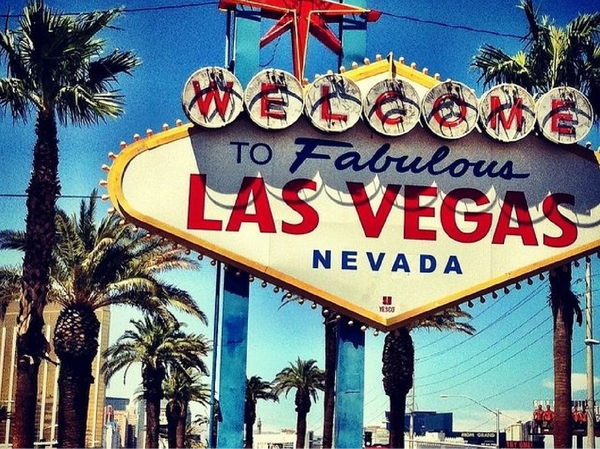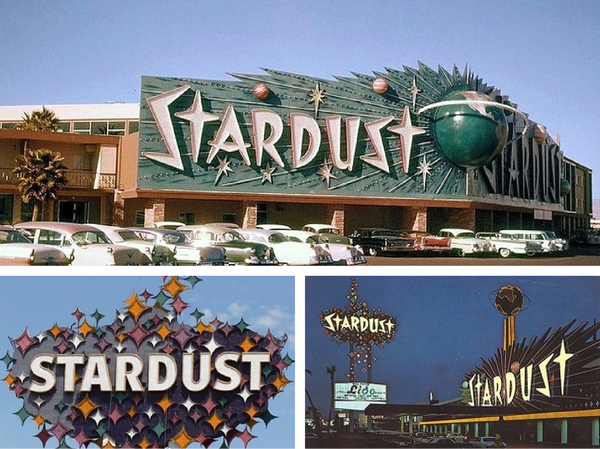One thing we have to love about Las Vegas is that it's truly a city that honors and respects its signage history. There are sort of two epochs of iconic signage in Las Vegas: one spanning from the early 1930's to the 1990's and the other spanning from the 1990's to present. The first one exemplifies the Rat Pack version of Vegas and spawned some of the most iconic signs the city has come to take on as historic landmarks. This was back when the most popular glittering and spangled casinos and hotels were located on Fremont Street instead of the Strip. As the 1980's waned into the 1990's, many of the original signs were taken down and put into a "neon boneyard." Thankfully, as the historic signs were coming down and making way for new ones, the city of Las Vegas decided (with its trademark love of showmanship) to resurrect some of the old signs and turn them into an outdoor museum and the "Fremont Street Experience"—an over-the-top lights show featuring the neon and electric bulb lights of the famous 20th Century signs—respectively.
In this "Iconic Signage" blog post, we're going to focus on signs from the first era of great Las Vegas signage—mostly built in or around the first half of the 20th Century. Although it would be nearly impossible to talk about all of the iconic signs from that time (unless we wrote a whole book!), here are a few that we think are particularly notable.
1. The Boulder Club
 See the Hoover/Boulder Dam?
See the Hoover/Boulder Dam?
It would be impossible to talk about Las Vegas' iconic signage without talking about the Young Electric Sign Company (YESCO). Although it began in Utah in 1920 with Thomas Young, the company went on to open a branch on Fremont Street near the Hotel Apache and to make some of the city's most iconic and beloved signs. In fact, they were the sign company that built the very first neon sign in Las Vegas! This sign was for the Boulder Club located on Fremont street. Actually, YESCO made several signs for the Boulder Club, beginning in 1933 with a vertical sign that reached about 10 feet above the roof line. In 1945 the sign got a neon makeover that included a marquee and a towering structure with the casino's name in bright lights. The face of the marquee also includes an image of the Hoover (originally known as "the Boulder") Dam. Unfortunately, The Boulder Club burned down in the 1960's and was never reopened. The building was purchased and became a part of the Horseshoe Club.
2. Vegas Vic (The Pioneer Club)

Vegas Vic has had some costume changes over the years. He was originally painted with a white and yellow checked shirt that was then painted completely yellow in the 1970's and finally updated to the yellow and red checked version he wears today.
This 40-foot smiling cowboy has been the unofficial greeter to all those visiting Las Vegas since 1951. The image of "Vegas Vic" first appeared on the scene when in 1947 the Las Vegas Chamber of Commerce wanted a sort of mascot designed to draw people to the city. They hired a design company that came up with the friendly cowboy with the catchphrase "Howdy podner!" The image became immediately popular and The Pioneer Club casino wanted a neon sign in Vic's image to welcome tourists to their establishment. Of course, as the reigning kings of Las Vegas neon, YESCO was hired to do the job. They in turn hired Pat Denner to create a design of Vic that they turned into a moving neon mascot for the casino. Originally Vic would wink his eye, wave his arm, and puff on his cigarette that would then blow smoke rings. The red circle on his shirt pocket is meant to represent the tag on a bag of tobacco since cowboys used to roll their own cigarettes from pouches of tobacco. He also bellowed a genial "Howdy podner!" about ever fifteen minutes. This famously annoyed actors Lee Marvin and Woody Strode, who were staying across the street at The Mint Hotel while shooting the western film The Professionals. The two actors spent the night shooting arrows at the metal cowboy and subsequently made the papers (and history) as Vic was silenced by The Pioneer Club for the next two decades. Although The Pioneer Club is no longer in business, Vegas Vic has proved more resilient and still smiles at tourists on Fremont street—now above a souvenir shop owned by Schiff Enterprises.
3. Las Vegas Welcome Sign

Betty Willis' sign has become one of the most iconic signs of all time.
Is there any sign in the world more iconic than this one? This sign was funded in 1959 by Clark County, NV and designed by graphic designer Betty Willis for the Western Neon sign company. Willis designed the sign in the popular "Googie" style of architecture that we now think of as being synonymous with the Atomic Era of America—notable for it's love of curvy geometric designs that tended to use chrome, steel, glass, and neon in its production. The 25-feet-tall classic road sign consists of an elongated metal diamond with hand-painted lettering, neon tubing, a painted neon starburst, and blinking incandescent lights along the rim. The silver circles behind the word "welcome" are supposed to represent silver dollars in a nod to Nevada's nickname of "The Silver State." Part of what has made this sign so iconic is the fact that Willis never trademarked the design of the sign so it's been put on virtually every type of souvenir and touristy paraphernalia imaginable. "It's my gift to the city," she said. The sign itself is now owned by YESCO (seriously, what sign don't that have a connection to in this town?!) and leased to the county.
4. Stardust Resort and Casino

I personally prefer the original Googie typeface. What do you think?
Here's yet another YESCO creation that no longer graces the Las Vegas skyline. This casino resort once had the most popular shows on the strip with it's French-inspired Lido, a "Big Dipper" swimming pool, giant casino, and the first drive-in movie theater on the strip. The sign was designed by Kermit Wayne from the ideas of Tony Cornero—the original owner whose untimely death in 1955 before construction was completed in 1958 turned ownership of the Stardust over to John Factor. The front marquee sign gave visitors to Las Vegas a panoramic view of the solar system. Like Betty Willis' sign, the Stardust building and road signs are inspired by Googie architecture. Later on the original typeface used for the signs was changed to the more muted Futura. There was about 7,100 feet of neon tubing in the sign along with over 11,000 light bulbs used in the 216-feet-long front of the sign. Apparently, there were 975 lamps in the "S" of Stardust alone. In the center of the enormous galactic sign was a 16-ft model of the earth that would raise above casino. Locals reported that the bright face of the casino could be seen over 60 miles away!
So, what other signs do you think should be included in this list? Tell us about your favorite Las Vegas signs down in the comments!
Looking for your own iconic signage? Click the button below!



Leave a Reply